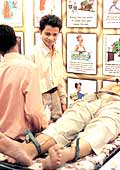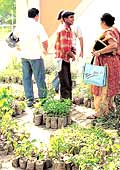 |
 |
| Naturopathy craze: More
like a craze for freebies; this stall promises free check-ups
for all comers |
SATURDAY, SEPTEMBER 24,
2005
Pragati Maidan, New Delhi, 4.30 p.m.
Indians
of a certain age, and of a certain provenance (those from Tamil
Nadu and West Bengal, for instance), love to complain about their
ailments, real and imagined. Most conversations revolving around
this tend to end with at least one individual in the gathering
proffering the coordinates of a homoeopath, naturopath, or practitioner
of ayurveda, siddha, or unani-essentially someone who follows
anything but allopathy-who routinely effects miracle-cures. Now,
I have an open mind when it comes to most things, but I must admit
that it was with a certain amount of trepidation that I ventured
into Arogya, an alternative medicine system fair that opened in
Delhi's Pragati Maidan, a popular destination for industrial fairs,
recently.
 |
| Local silicone? Well, that's
what Hamdard's latest offering promises, and minus the surgery |
The first thing that strikes me is that there
is enough alternativeness on display at the fair: an ayurvedic
vaid (doctor) at a stall put up by Dabur, a 121-year-old company
that has made its fortune (sales of some Rs 1,537 crore in 2004-05)
by packaging ayurvedic formulations fast-moving-consumer-goods
fashion. There is a unani hakim (doctor, again) at a stall put
up by Hamdard, another such company. And some very impressive
young men and women sporting white doctors' jackets are bustling
around a stall put up by Chandola Homeopathic Medical College
and Hospital (based in Rudrapur, a town in Uttaranchal some 255
km to the north-east of Delhi, if you must know), their very western
costumes clashing with the medicine system they are selling. The
stall of the National Institute of Siddha (founded: September
3, 2005) has neither doctor nor students; instead, it proudly
displays a large photograph of ministers from Tamil Nadu who are
part of the UPA government (the visage of Anbumani Ramadoss, the
Union Minister for Health, smiles down on me) and Prime Minister
Manmohan Singh.
India, it emerges, isn't just a great melting
pot of cultures; it is also one of medicine systems. Most stalls
display the same herbs, and even as I am digesting the fact that
ayurveda's central principle of well-being, revolving around a
balance of vak, pith and kaph is the same as siddha's core premise
of everything having to do with vatham, pittham and kappam (the
reaction of the central and autonomic nervous systems, digestive
system, and skeletal and muscular system respectively), I feel
something running over my back and neck. It turns out to be an
acupressure product, a "vibrator comb" as it is intriguingly
named. "Yours for Rs 125," says the unctuous salesman,
as he tries to demonstrate the product with me as the subject,
the target this time being my arm. I dodge him and come face to
face with another of the breed (salesman, that is, not vibrator-combs).
"Omega 3 is the only truth you see here," this one intones,
singing the benefits of Omega 3 oil extracted from flaxseed. It
later dawns on me that the Omega 3 oil (with its proven capability
of reducing the chances of cancer and cardiac ailments) is probably
the only thing on display at the fair whose claims have the support
of modern science.
 |
| Beyond boundaries: Ayurvedic
medicines seem to be quite the rage with foreigners too |
Most of the principles behind India's systems
of traditional medicine are still beyond the comprehension of
Western and Indian scientists. India, a country that produces
a fifth of the world's generics (read: drugs that go off patent)
but is yet to produce even a single original one, can only establish
ayurveda as a credible system of medicine when its scientists
prove the efficacy of its medicines (a time- and data-intensive
process that even makers of allopathic drugs struggle with). That's
easier said and done in the case of ayurveda, siddha and the like.
"Lead in any concentration is toxic," says R.A. Mashelkar,
Director General, Council of Scientific and Industrial Research.
"Yet, it is considered a fast healing agent and is used quite
freely by siddha practitioners, and there is no reporting of toxic
effects." "Is it that the herbs in the medicines get
pyrolised and a complex between the pyrolised herb and the element
is formed, which then becomes the active compound?" he asks.
CSIR has some 500 scientists working to answer that question,
and several others related to ayurvedic cures. "We have to
push for ayurveda to be recognised as a system of medicine,"
says Gopal K. Pillai, an additional secretary in India's Ministry
of Commerce and Industry that has identified it as an export opportunity
going waste.
Then, the 3,000-year-old medicine system is
in the news for all the wrong reasons, like a recent article in
December 2004 issue of the Journal of the American Medical Association
that alleges that some ayurvedic medicines are toxic (and the
consequent ban of the medicines in Canada). Uma Pillai, Secretary,
Ministry of Health and Family Welfare, may bravely maintain that
such articles are the result of ignorance and business rivalry,
but fact is, the Indian approach to selling ayurveda is based
more on belief and less on science. And the presence of around
750,000 practitioners of alternative medicine systems, and of
around 9,000 pharmacies of the same in the country helps (as compared
to some 650,000 allopaths).
 |
 |
| Free and for sale: Another
free check-up at another stall (L) while some visitors snap
up rare herbs |
"Earlier we used to receive only chronic
cases where patients had run out of allopathic options,"
says Dr T. Bikshapathi, Director, Central Research Institute,
the Central Council for Research in Ayurveda and Siddha (CCRAS).
"Now we get them early." Much of that has to do with
word-of-mouth publicity. Over the past seven years, for instance,
Ranjit Puranik has seen his ayurvedic medicines firm Shree Dhootapapeshwar
Ltd (it is 125 years old) grow seven times.
The real crowd-magnet at Arogya, however,
are the unani stalls that are attracting attention of precisely
the kind they do not want. "Street-hakims have given our
industry a bad name," says Mohsin Dehlvi, whose Dehlvi Remedies,
the man claims, is doing its bit to change popular perception
that unani medicines are "sex medicines". In the same
breath he tells me that his company's best-selling product is
libido-enhancer Wajid Shah, which contains the excreta of sperm
whales "collected from coastal Andamans for upward of Rs
6,50,000 a kg". "Eighty per cent success rate,"
he whispers to my back as I leave his stall.
|









